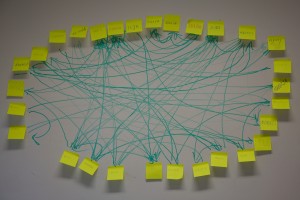
Amongst children and young people the point prevalence of depression ranges from 1.9-3.4% in primary school children and from 3.2-8.9% in adolescents (Birmaher et al, 1996; Costello et al, 2003; Kovacs et al, 1984).
The use of medication to treat depression in children and young people is somewhat controversial due to mixed evidence concerning the efficacy and safety of antidepressants, alongside evidence of an increased risk of suicidal behaviour in children and adolescents (Jureidini et al, 2004; Qin et al, 2014). Accordingly, clinical practice guidelines recommend that psychotherapy be considered as the first-line treatment for mild to moderate depression in children and young people and medications used only for severe cases or for those who do not benefit from psychotherapy (NCCMH, 2005).
There are several types of psychotherapies available for treating depression in children and young people (Weisz et al, 2006; Weisz et al, 2013). Whilst it is generally accepted that various forms of psychotherapy are beneficial for treating depression in children and young people, recent systematic reviews and meta-analyses have challenged this. For instance, Weisz et al. (2006) found the effect sizes for cognitive behaviour therapy (CBT) to be much lower than those documented in a previous meta-analysis by Reinecke et al (1998). Moreover, there are some discrepancies between meta-analyses that suggest CBT is superior to non-cognitive treatments (David-Ferdon & Kaslow, 2008; Watanabe et al, 2007) and meta-analyses which suggest that non-cognitive treatments such as interpersonal therapy (IPT) are as efficacious as cognitive treatments (Hetrick et al, 2015).
Traditionally, the efficacy of different forms of psychotherapy for children and young people has been investigated using a pairwise meta-analysis which allows a direct comparison between either two different psychotherapies or psychotherapy and a control condition. This method of investigation is somewhat limited, however, due to the inability to compare the efficacy of interventions that have not been directly compared in a trial, meaning that to date there has been no established definitive ranking of psychotherapies for children and young people.
The current study therefore utilised a network meta-analysis, a method which integrates direct evidence with indirect evidence, with the aim of providing a comprehensive and hierarchical evidence of the efficacy and acceptability of all psychotherapies for treating depression in children and young people.

Previous meta-analyses have failed to compare several different psychotherapies for depression at once.
Methods
Study selection criteria
Studies were selected if the following criteria were met:
- A prospective RCT method was used
- Participants were aged 6 to 18 years at the time of study
- Participants had a clinical diagnosis of major depression, minor depression, intermittent depression, dysthymia depression or exceeded a predefined threshold for depressive symptoms using a validated depression severity measure. This included studies which had patients with comorbid psychiatric disorders
- The study contained any manualised or structured psychotherapy compared with either another class of psychotherapy or a control condition.
Studies were excluded if they:
- Recruited participants with treatment-resistant or psychotic depression
- Involved combination therapies
- Focused on maintenance treatment or relapse prevention
- Involved a psychotherapy intervention that was not specifically aimed at treating depression.
Eight electronic databases (PubMed, EMBASE, Cochrane, Web of Science, PsychINFO, CINAHL, LILACS and ProQuest Dissertations) were searched from January 1st 1966, to July 1st 2014 with medical subject headings (MeSH) and text words.
Study outcomes
- The primary outcome was efficacy at post-treatment which was measured by mean changes in scores in depressive symptoms from baseline to post-treatment
- The secondary outcome was efficacy at follow-up which was measured by mean changes in scores in depressive symptoms from baseline to the end of follow-up. Follow up data was extracted both for short term follow-up (1 to 6 months) and long-term follow-up (6 to 12 months).
- The final outcome was acceptability of treatment which was measured by the proportion of patients who discontinued treatment up to the post-intervention time point.
Data analysis
The authors performed Bayesian network meta-analysis, a novel analysis technique which in the context of a systematic review, is a meta-analysis in which multiple treatments (three or more) are compared using both direct comparisons of interventions within RCTs and indirect comparisons across trials based on a common comparator. For example, in the simplest case, one may be interested in comparing two interventions, CBT and IPT. Indirect evidence can be obtained from RCTs of either IPT or CBT with a common comparator of waiting list. When both direct and indirect evidence are available, the two sources of information can be combined as a weighted average when appropriate. This data can then be used to provide evidence to aid the selection of the best possible treatment option.
Results
The results of 52 RCTs were analysed including data from 3,805 participants. Overall, 2,361 patients were randomised to nine psychotherapies:
- Cognitive behavioural therapy (CBT)
- Interpersonal psychotherapy (IPT)
- Supportive therapy
- Cognitive therapy
- Family therapy
- Play therapy
- Behavioural therapy
- Problem-solving therapy
- Psychodynamic therapy
The remaining 1,444 participants were randomised to four control conditions (waitlist, no treatment, treatment as usual, psychological placebo).
Efficacy at post-treatment
At post-treatment, only IPT and CBT were significantly more effective than most control conditions (SMDs ranged from -0.47 to -0.96). The SMD is the difference in mean change scores from baseline to post-treatment between two groups divided by the pooled standard deviation of the measurements. A negative SMD value indicates greater symptomatic relief.). IPT and CBT were also significantly more effective than play therapy (SMDs = -0.93 and -0.80 respectively). Only psychodynamic and play therapy were not significantly more beneficial than waitlist.
Efficacy at follow-up
At follow-up IPT and CBT were again significantly more effective than most control conditions (SMDs ranged from -0.26 to -1.05). IPT and CBT were also significantly more effective than problem solving therapy (SMDs = -1.10 and -0.90 respectively). Only psychodynamic therapy and problem-solving therapy were not significantly more beneficial than waitlist.
Interestingly, data analysed at long-term follow-up showed that IPT was significantly more beneficial than CBT, cognitive therapy and most control conditions (SMDs ranged from -0.78 to -1.08). Conversely, CBT was not superior to any control condition at long-term follow up.
Acceptability
IPT and problem solving therapy had significantly fewer discontinuations than CBT and cognitive therapy (ORs ranged from 0.06 to 0.33). Problem solving therapy had significantly fewer discontinuations than psychological placebo (OR = 0.10; 95% CI: 0.02 to 0.98).

There were 9 runners but it was a two horse race with IPT and CBT significantly more efficacious than all the other psychotherapies at post-treatment and follow up.
Conclusions
The authors conclude that of the nine psychotherapies included in the network meta-analysis only IPT and CBT are significantly more beneficial for children and adolescents than control conditions at post-treatment and at follow up. Whilst both IPT and CBT demonstrated a robust effect over short term follow up, only IPT had a beneficial effect for children and adolescents at long term follow up. The theory behind IPT may resonate with young people in particular due to interpersonal difficulties being more likely to fuel psychopathologies at this age (Gunlicks-Stoesse, M. et al., 2010).
In relation to the acceptability of treatment, it was found that IPT and problem-solving therapy had significantly greater acceptance than CBT and cognitive therapy. A possible interpretation for this is that psychotherapies which place emphasis on cognitive changes may be more difficult for young people to engage in.
Strengths and limitations
Whilst publication bias in meta-analyses is a widely contended issue, recent studies have found that the results of psychotherapy research for depression are only marginally affected by publication bias (Niemeyer et al, 2013). The author’s inclusion of unpublished studies in this network meta-analysis should therefore be commended for contributing to this lack of publication bias.
The authors acknowledge that there are several limitations within their study. Network meta-analysis works by assuming that all treatments in one ‘node’ of the analysis are similar in rationale and procedure. However the authors state that the therapies considered as ‘family therapy’ were somewhat heterogeneous in their nature. Similarly, the control condition node of ‘treatment-as-usual’ may mean very different things in different mental health care contexts and in some cases may be little different to control conditions considered in the ‘no treatment’ node. In general, the authors do not expand very much on the conceptual heterogeneity of the studies included in this network meta-analysis. For instance there is no mention of the treatment duration in each of the studies, or the difference in follow up times between studies, or any differences in outcome measures or populations of the studies. It may therefore be inaccurate to make conclusions based on a comparison of several different types of studies.
In addition to this, the study excluded participants who were experiencing treatment resistant or psychotic depression. Due to the omission of these groups, this may have led the authors to overestimate the effect size of the psychotherapies. However, as noted above, it is this group of people for whom clinical guidelines recommend the use of medication, and this may aid the efficacy of psychotherapy in these instances.
Finally, the study only focused on three specific outcomes and did not choose to investigate several important outcomes pertinent to making a decision for which treatment may be best for a child or young person. For instance, data was not collected on adverse effects, cost-effectiveness, quality of life outcomes or suicide rates. Outcome measures within RCTs have recently generated much debate particularly around the involvement of service user researchers in the selection of outcome measures, which several have found to be different from those selected by clinicians or researchers (Crawford et al, 2011). Faulkner (2015) therefore encourages the inclusion of service user researchers in selection of outcome measures, in a bid to improve the RCT method.
Summary
This study has made an important contribution to the current evidence for the efficacy of psychotherapies in treating depression in children and young people. Where previous studies have failed to incorporate indirect evidence, this network meta-analysis has succeeded in evaluating the wider picture of psychotherapies for depression in children and young people, by placing all psychotherapies into a hierarchy.
The study concludes that:
Our review supports the notion that IPT and CBT, when available, should be the initial choice of psychological treatment for depression in children and adolescents.
Despite this, there is still a wealth of research to be conducted to investigate other psychotherapies which are under-researched in this population, as well as looking at outcomes other than efficacy and acceptability.

The study concludes that IPT and CBT should be the initial choice of treatment for depression in children and young people.
Links
Primary paper
Zhou X, Hetrick SE, Cuijpers P, Qin B, Barth J, Whittington CJ, Cohen D, Del Giovane C, Liu Y, Michael KD, Zhang Y, Weisz JR, Xie P. (2015) Comparative efficacy and acceptability of psychotherapies for depression in children and adolescents: a systematic review and network meta-analysis. World Psychiatry 2015 14 207-222.
Other references
The Health and Social Care Information Centre. Adult Psychiatric Morbidity in England – 2007, Results of a household survey. HSCIC, 27 January, 2009.
Birmaher et al (1996) Childhood and adolescent depression: a review of the past 10 years. Journal of American Academic Child and Adolescent Psychiatry; 35: 1427-1439.
Costello et al (2003) Prevalence and development of psychiatric disorders in childhood and adolescence. Arch Gen Psychiatry; 60: 837-844.
Kovacs et al (1984) Depressive disorders in childhood. I. A longitudinal prospective study of characteristics and recovery. Arch Gen Psychiatry; 41: 229-237. [PubMed abstract]
Jureidini et al (2004) Efficacy and safety of antidepressants for children and adolescents. BMJ; 328: 879-883.
Qin et al (2014) Selective serotonin reuptake inhibitors versus tricyclic antidepressants in young patients: a meta-analysis of efficacy and acceptability. Clinical Therapy: 36; 1087-1095. [PubMed abstract]
NCCMH (National Collaborating Centre for Mental Health) (2005) Depression in children and young people: identification and management in primary, community and secondary care. Leicester and London: British Psychological Society and Royal College of Psychiatrists. [PubMed abstract]
Weisz et al (2006) Effects of psychotherapy for depression in children and adolescents: a meta-analysis. Psychology Bulletin: 132; 132-149.
Weisz et al (2013) Performance of evidence-based youth psychotherapies compared with usual clinical care: a multilevel meta-analysis. JAMA Psychiatry: 70; 750-761.
Hetrick et al (2015) Back to basics: could behavioural therapy be a good treatment option for youth depression? A critical review. Early Intervention Psychiatry: 9; 93-99.
Gunlicks-Stoessel et al (2010) The impact of perceived interpersonal functioning on treatment for adolescent depression: IPT-A versus treatment as usual in school-based health clinics. Journal of Consultant Clinical Psychology: 78; 260-267.
Niemeyer et al (2013) Publication bias in meta-analyses of the efficacy of psychotherapeutic interventions for depression. Journal of Consulting and Clinical Psychology: 81; 58-74.
Crawford et al (2011) Selecting outcome measures in mental health: The views of service users. The Journal of Mental Health: 20; 336-346
Faulkner, A. (2015) Randomised controlled trials: The straitjacket of mental health research? The McPin Foundation.

IPT and CBT best for depression in children and young people, says network… https://t.co/3Dc0tqlRe0 #MentalHealth https://t.co/EhM1xFLNNx
@Mental_Elf 12 week waiting list….if you can get on the list. Long time for child or young person.
IPT and CBT best for depression in children and young people, says network meta-analysis https://t.co/P34vx1E2FH
Network meta-analysis of psychotherapies for depression in children and adolescents https://t.co/7GjuU26UDQ
@Mental_Elf important study but conclusion not supported by the data it should be that CBT/IPT are first line psychological RX
Welcome to the woodland Laura Hemming from @McPinFoundation https://t.co/7GjuU26UDQ Great to publish your debut blog!
IPT & CBT best for #depression in #children & young people, says network #metaanalysis https://t.co/EjWgN4f3Uq
Chloe Grace Morris Emma Jacqueline Donohue ? xx
[…] Read analysis of the article via the Mental Elf Blog […]
NO, no, no, no, no, no, no, no, no, no, NO! Please just stop it with the meta-analyses on highly heterogeneous therapies!
You even state, “Network meta-analysis works by assuming that all treatments in one ‘node’ of the analysis are similar in rationale and procedure. However the authors state that the therapies considered as ‘family therapy’ were somewhat heterogeneous in their nature. Similarly, the control condition node of ‘treatment-as-usual’ may mean very different things in different mental health care contexts and in some cases may be little different to control conditions considered in the ‘no treatment’ node. In general, the authors do not expand very much on the conceptual heterogeneity of the studies included in this network meta-analysis.”
This means, they should NOT have done a network meta-analysis given the knowledge that there was so much heterogeneity. Your Summary is therefore VOID!
Depression in children: IPT & CBT significantly more efficacious than other psychotherapies https://t.co/7GjuU26UDQ
Bayesian network meta-analysis reviews 52 RCTs of 9 different psychotherapies for depression in children https://t.co/7GjuU26UDQ
Don’t miss: IPT and CBT best for depression in children and young people, says network meta-analysis https://t.co/7GjuU26UDQ
IPT and CBT best for depression in children and young people, says network meta-analysis https://t.co/waMDcwtLLd
IPT and CBT best for depression in children and young people, says network meta-analysis https://t.co/HwLOFFKWoL via @sharethis
Excellent @Mental_Elf blog by Laura Hemming on IPT and CBT for depression in children and young people: https://t.co/tOB32cEptY
IPT and CBT best for depression in children and young people, says network meta-analysis. https://t.co/FFzCX9VOuL #TopShared24hrs #3
IPT and CBT best for depression in children and young people, says network meta-analysis https://t.co/bEBxIKUwIH via sharethis
IPT and CBT best for depression in children and young people, says network meta-analysis https://t.co/RsYLbKzDYC via @sharethis.